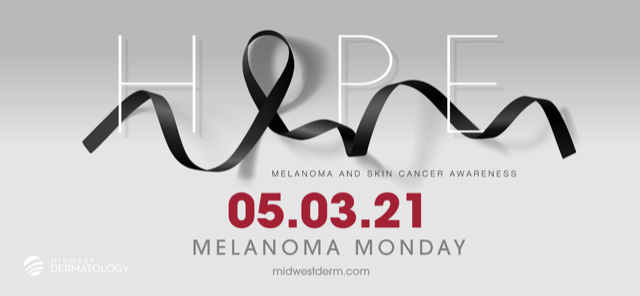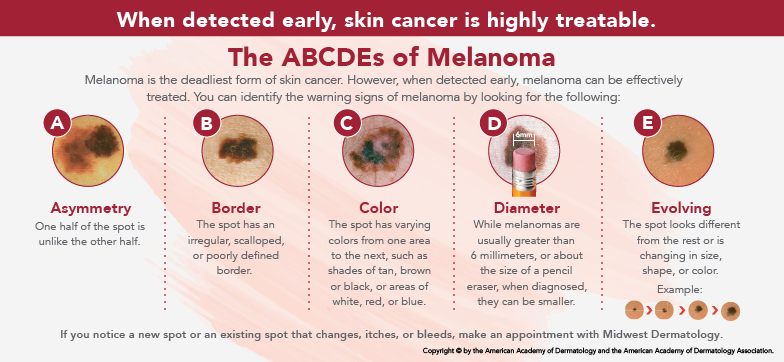MAKE MAY 3rd A DAY TO REMEMBER

May 3 is Melanoma Monday, and we’re here to tell you it’s way more than just another specialty recognition day.
For our team, it’s a time to pause to remember those who were taken from us by malignant melanoma, the most dangerous and deadly form of skin cancer. As dermatologists, we see melanoma on a pretty regular basis.
What we want May 3 to be for you is a day to know and remember that melanoma is preventable, and mostly curable if caught early.
So get to know the facts and some of the stats below and use them as motivation to make an appointment to have that suspicious looking mole examined at Midwest Dermatology. Or share a meaningful statistic with a family member or friend and offer to take them in for their appointment.
Melanoma Is on the Rise in Men and Women.
- The number of new melanoma cases will increase by 5.8 percent this year.
- The number of melanoma deaths will increase by 4.8 percent this year.
- Melanoma can be either in situ (noninvasive), confined to the epidermis (the top layer of skin OR it can be invasive (penetrating the dermis – the second layer of skin).
- Invasive melanomas are more common in males, but affect both men and women.
- An estimated 7,200 people will die of melanoma in 2021. Of those, 4,600 will be men and about 2,500 will be women.
- If you have a close relative—a parent or sibling—who has had melanoma, your risk increases by about 50%.
- Men age 49 and under have a higher probability of developing melanoma than any other cancer.
- Women age 49 and under are more likely to develop melanoma than any other cancer except breast and thyroid cancers.
Understanding the Sun’s Role in Melanoma.
- The vast majority of melanomas are caused by the sun. One study estimates that 86 percent of melanomas can be attributed to exposure to ultraviolet light from the sun.
- On average, a person’s risk for melanoma doubles if they have had more than five sunburns. And just one blistering sunburn in childhood or adolescence more than doubles a person’s chances of developing melanoma later in life.
- Ultraviolet (UV) radiation is a proven human carcinogen.
- Indoor tanning devices can emit UV radiation in amounts 10 to 15 times higher than the sun at its peak intensity.
- More than 6,200 cases of skin cancer in the U.S. each year are linked to indoor tanning.
- More people develop skin cancer because of indoor tanning than develop lung cancer because of smoking.
Encouraging Statistics About Melanoma.
- If caught in the earliest stages, melanoma is entirely treatable, but because it spreads quickly, early detection and immediate treatment is critical.
- When detected early, the 5-year survival rate for melanoma is 99 percent.
- Regular daily use of an SPF 30 or higher sunscreen reduces the risk of developing melanoma by 50 percent.
- You can lower your risk of melanoma by protecting your skin. When you’re outside between 10 a.m. and 4 p.m., seek shade (or better yet, avoid it altogether). Wear protective clothes—long sleeves, long pants, a broad-brimmed hat, and sunglasses. Use a water-resistant sunscreen (link to our store) with a sun protection factor (SPF) of 30 or higher and reapply every two hours.
Even if you don’t remember everything, don’t forget that melanoma is on the rise, melanoma is clearly linked to sun exposure and bad sunburns, and melanoma is treatable if it’s found and treated early.
KNOW YOUR ABCDE’S – AN EASY TRICK TO RECOGNIZE THE WARNING SIGNS

